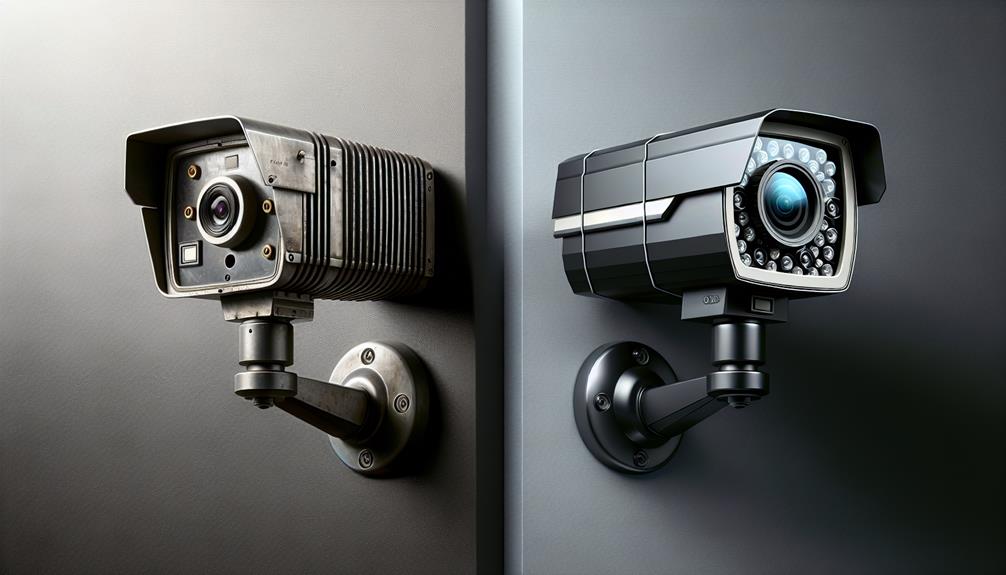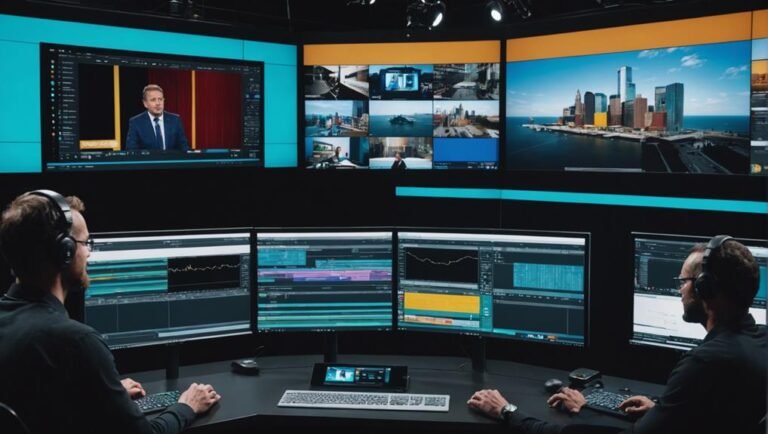When comparing analog CCTV to digital CCTV, think about image quality first. Analog CCTV offers decent security but caps at 0.4 megapixels. Digital CCTV excels with over 5 megapixels, providing sharper images and better color accuracy. Storage also differs: analog uses DVR, while digital leverages NVR and cloud storage for flexibility. Installation is simpler for digital systems, thanks to Ethernet cables and PoE compatibility. Analog systems might be cheaper initially, but digital CCTV offers unmatched scalability and advanced features like smart home integration and remote access. Stick around to discover all the nuanced differences and benefits.
Definition of Analog CCTV
Analog CCTV refers to a traditional surveillance system that uses analog signals to transmit video footage. If you’re looking for a straightforward way to monitor your property without the complications of modern tech, this might be your go-to. Analog CCTV systems capture video with cameras, which then send the footage through coaxial cables to a Digital Video Recorder (DVR). The DVR converts the analog signals into digital format, making it easier to store and review later.
You might appreciate the simplicity and reliability of analog CCTV. These systems are generally less expensive upfront and easy to set up. You won’t need to worry about complex network configurations or software updates. Plus, analog cameras are usually robust and durable, perfect for those who value straightforward, no-nonsense security.
However, keep in mind that analog CCTV does come with limitations. The image quality is often lower than digital systems, and you might find it challenging to scale up if you need more cameras. But if you’re after a cost-effective, easy-to-use solution that gets the job done, analog CCTV offers a solid choice. It’s a way to maintain your freedom without getting bogged down by tech complexities.
Definition of Digital CCTV
Digital CCTV systems use advanced technology to capture and transmit high-quality video footage over internet protocols. With digital CCTV, you’re not bound by the limitations of older analog systems. Instead, you have the freedom to access, monitor, and control your security footage from virtually anywhere. All you need is an internet connection and a device like a smartphone or laptop.
These systems convert video footage into digital data, which means they can be easily stored on hard drives, cloud services, or network-attached storage. You’re no longer tied to physical tapes or limited storage space. Digital CCTV also integrates seamlessly with other modern tech, allowing for features like motion detection, facial recognition, and smart alerts. This integration provides you with a robust and flexible security solution.
Moreover, digital CCTV systems often come with user-friendly software, making it simple for you to customize settings, review footage, and manage multiple cameras. The clarity and precision of digital footage enable you to zoom in on details without losing quality, empowering you to keep a keen eye on what matters most. Embrace the freedom that digital CCTV offers, and enhance your security setup with cutting-edge technology.
Image Quality Comparison
When comparing image quality, you’ll immediately notice the stark difference between older analog systems and modern digital CCTV. Analog cameras typically produce lower-resolution images, making it tougher to capture fine details. On the other hand, digital CCTV offers a higher resolution, providing clearer and more detailed footage that can make a significant difference in identifying important elements.
Consider these key points:
- Resolution: Analog cameras usually max out at around 0.4 megapixels, while digital cameras can easily exceed 5 megapixels or more. This difference allows digital systems to capture intricate details that analog simply can’t.
- Clarity: Digital CCTV provides superior image clarity. Whether it’s day or night, digital systems offer better color accuracy and less noise interference, which can be vital in identifying individuals or objects.
- Zooming Capabilities: With digital CCTV, you can zoom in on footage without losing much detail, thanks to higher resolution. Analog footage often becomes blurry and pixelated when zoomed in.
- Wider Coverage: Digital cameras often have a wider field of view, allowing you to cover more area with fewer cameras. This not only saves money but also reduces installation complexity.
Storage Solutions
When deciding between analog and digital CCTV systems, you’ll find that storage solutions play a significant role in determining the overall efficiency and cost-effectiveness of your setup. Analog systems usually rely on Digital Video Recorders (DVRs) with hard drives to store footage. This method can be limiting since the storage capacity is fixed and expanding it often requires replacing or adding physical drives.
On the other hand, digital CCTV systems utilize Network Video Recorders (NVRs) and often offer cloud storage as an option. NVRs can store footage on local servers or network-attached storage (NAS) devices, giving you more flexibility. Cloud storage provides the ultimate freedom, allowing you to access your footage from anywhere with an internet connection. Plus, you can easily scale your storage needs without worrying about physical constraints.
Digital systems typically use more efficient compression algorithms, reducing the amount of space each video file occupies. This makes them more cost-effective in the long run, as you won’t need to invest in additional storage as frequently. By choosing digital, you’ll gain a more scalable, flexible, and accessible storage solution, freeing you from the limitations of traditional analog systems.
Installation Process
Setting up your CCTV system involves different installation processes depending on whether you choose an analog or a digital setup. If you’re leaning toward analog, you’ll find it’s simpler when it comes to wiring. Analog systems use coaxial cables to connect each camera to a DVR. On the other hand, digital systems, often referred to as IP cameras, use network cables like Ethernet, which can also supply power to the cameras if they are PoE (Power over Ethernet) compatible.
Here’s a quick breakdown of what you can expect with each type:
- Analog Installation:
- Run coaxial cables from each camera to the DVR.
- Provide separate power supplies for each camera.
- Set up the DVR to record and store footage.
- Connect the DVR to a monitor for live viewing.
- Digital Installation:
- Use Ethernet cables to connect each camera to a network switch.
- Make sure your cameras are PoE or use a separate power source.
- Configure your NVR (Network Video Recorder) or cloud storage.
- Access your footage remotely via a smartphone or computer.
Choosing between analog and digital boils down to your preference for simplicity versus advanced features. Analog is straightforward but limited, while digital offers flexibility and remote access.
Cost Analysis
While evaluating costs, you’ll find that analog CCTV systems generally have a lower initial investment compared to digital systems. This aspect can be particularly appealing if you’re operating on a tight budget or just getting started. The cameras, cabling, and recording equipment for analog systems tend to be cheaper. However, don’t overlook the long-term expenses, as they can add up quickly.
Consider the table below for a clearer picture:
| Cost Element | Analog CCTV | Digital CCTV |
|---|---|---|
| Initial Camera Cost | Lower ($50-150) | Higher ($200-500) |
| Cabling | Coaxial (cheaper) | Ethernet (costlier) |
| DVR/NVR Equipment | Lower ($300-600) | Higher ($500-1000) |
| Maintenance | Moderate | Lower |
| Scalability | Limited | High |
Analog systems might save you money upfront, but digital systems offer better scalability and potentially lower maintenance costs. Digital cameras often include advanced features like higher resolution and better image quality, which might justify their higher price.
You should also factor in the potential for future upgrades. Digital systems are generally more adaptable, allowing you to add more cameras and features without a complete overhaul. This flexibility can be a significant advantage, giving you more freedom to expand as your needs grow.
Integration Capabilities
Digital CCTV systems excel in integration capabilities, allowing seamless connectivity with other security and smart home devices. You can effortlessly link your digital CCTV to various technologies, creating a thorough and robust security network that suits your freedom-centric lifestyle. The beauty of this system lies in its flexibility and adaptability, empowering you to tailor your security setup to your unique needs.
Here’s how digital CCTV enhances your security experience:
- Smart Home Integration: Sync your CCTV with smart home devices like smart locks, lighting systems, and even voice assistants. This integration lets you control your entire security ecosystem from a single interface, maximizing convenience.
- Advanced Analytics: Digital systems often come with AI-driven analytics, such as facial recognition and motion detection. These features can be seamlessly integrated into your existing security infrastructure to provide real-time alerts and insights, enhancing your situational awareness.
- Third-Party Compatibility: Digital CCTV systems are typically designed to work with third-party software and hardware, giving you the freedom to choose the best-of-breed components to enhance your security setup.
- Scalability: Easily expand your security network by adding new cameras and devices without major overhauls, ensuring your system grows with your needs.
Accessibility and Remote Viewing
Beyond their integration capabilities, digital CCTV systems offer unparalleled accessibility and remote viewing options, allowing you to monitor your property from anywhere in the world. You’re not tied to a single location or device. With digital systems, you can access live feeds and recordings through your smartphone, tablet, or computer. This flexibility means you can be on a beach, in a meeting, or halfway across the globe and still keep an eye on your home or business.
Imagine the freedom of knowing you can check in anytime, day or night, with just a few taps on your device. Digital CCTV systems often come with user-friendly apps that send real-time alerts and notifications if any suspicious activity is detected. You can even control cameras remotely, adjusting angles or zooming in for a closer look. This level of control and immediacy simply isn’t available with analog systems.
For those who value autonomy and peace of mind, digital CCTV’s remote viewing capabilities are a game-changer. You’re no longer confined by physical boundaries; your surveillance extends as far as your internet connection reaches, giving you the ultimate freedom to stay connected and secure.
Scalability Options
When it comes to scaling your surveillance system, digital CCTV offers you unmatched flexibility and ease of expansion. Unlike analog systems, which can be cumbersome and limited, digital setups let you add cameras and functionalities effortlessly. Here’s why digital CCTV is your go-to choice for scalability:
- Network Integration: Digital cameras connect via your existing network, making it simple to add more cameras without extensive rewiring. Just plug them into your network switch, and you’re good to go.
- Storage Options: With digital systems, you can easily expand storage by adding more hard drives or opting for cloud storage. This means you’re never limited by physical storage constraints.
- Remote Configuration: You can configure and manage additional cameras remotely. No need to be physically present to tweak settings or integrate new devices, saving you time and hassle.
- Advanced Features: Digital systems often come with advanced features like motion detection, facial recognition, and analytics, which can be easily scaled as your needs grow.
Digital CCTV systems offer you the freedom to expand and adapt your surveillance network as your requirements change. You won’t face the constraints typical of analog setups, making digital the clear winner for a scalable solution.
Reliability and Maintenance
Given the importance of consistent surveillance, ensuring the reliability and ease of maintenance of your CCTV system is crucial. Analog and digital systems each have their strengths and weaknesses in this area, and understanding these can help you make an informed choice.
Analog systems typically offer more straightforward maintenance. Their components are generally less complex and easier to replace. However, they may require more frequent checks to guarantee all parts are functioning correctly. Digital systems, on the other hand, boast advanced diagnostics and remote access features that simplify maintenance tasks. Yet, they can be more complex to troubleshoot and fix when issues arise.
Here’s a quick comparison:
| Aspect | Analog CCTV | Digital CCTV |
|---|---|---|
| Maintenance Ease | Simple, manual checks | Advanced, remote diagnostics |
| Reliability | Consistent but needs frequent checks | High reliability with self-checks |
| Component Complexity | Less complex, easier to replace | More complex, harder to fix |
| Downtime | Potentially higher | Typically lower |
| Technological Support | Often limited | Usually extensive |
With analog, you gain simplicity and ease of replacement, but at the cost of frequent manual checks. Digital systems offer superior reliability and remote maintenance capabilities, though they demand a bit more tech-savviness to manage. Choose the one that aligns with your freedom to maintain and monitor effectively.
Frequently Asked Questions
What Are the Common Security Risks Associated With Each Type of CCTV System?
Isn’t it ironic that CCTV systems, meant to safeguard, come with their own security risks? Analog systems are vulnerable to physical tampering, while digital systems face hacking threats. So, freedom comes with a touch of caution.
How Does Weather Impact the Performance of Analog Vs Digital CCTV Cameras?
Weather affects both systems differently. Analog cameras might struggle with image clarity in bad weather. Digital cameras generally handle weather better but may experience network issues. Choose the right system based on your specific environmental needs.
Can Analog and Digital CCTV Systems Be Used Together in a Hybrid Setup?
Yes, you can use analog and digital CCTV systems together in a hybrid setup. By integrating them, you’ll enjoy the flexibility and freedom to upgrade gradually without losing your existing investments in analog technology.
What Are the Environmental Impacts of Analog and Digital CCTV Systems?
You’ll find that both CCTV systems have environmental impacts. Digital systems consume more power and require electronic waste management. Analog systems use less power but may need frequent replacements, leading to more waste. Choose wisely.
Do Analog and Digital CCTV Systems Require Different Types of Cabling?
Yes, they do. You’ll need coaxial cables for analog CCTV systems, while digital systems typically use Ethernet cables. Choosing the right cabling lets you set up your surveillance system without restrictions and guarantees the best performance.



